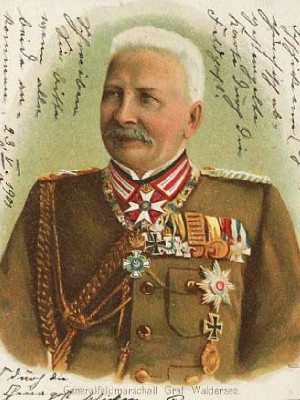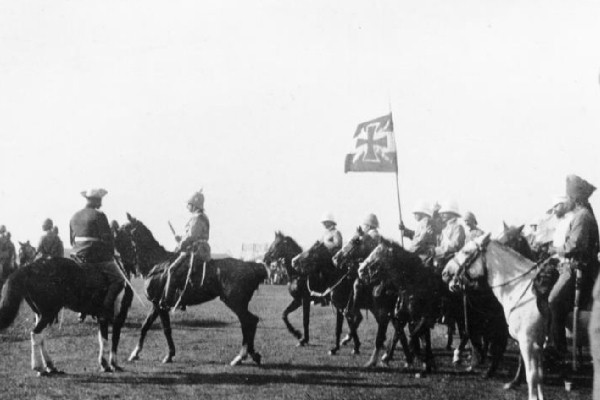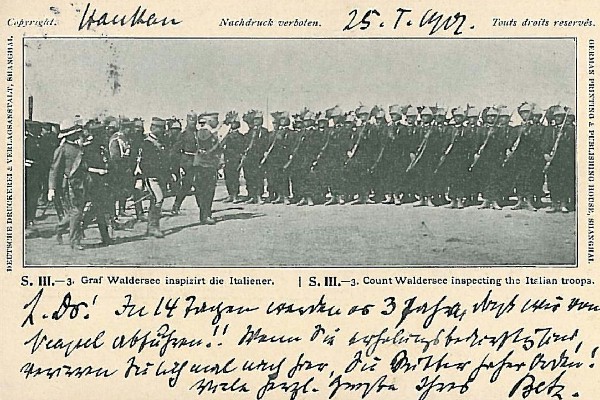|
Tropical Uniforms of the
Imperial and General Staff
Palestine 1898, China 1900-01 and Ethiopia 1905 |
| |
|
|
|

Figure 1
Kaiser Wilhelm II
1898 |
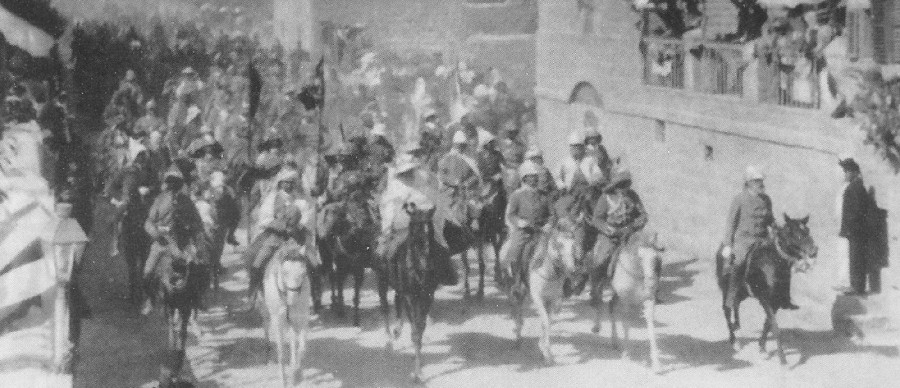
Kaiser Wilhelm II and his Staff in Jerusalem 1898
Photo from
WikiCommons
Kaiser Wilhelm
II's Expedition to Palestine 1898
The Kaiser had a passion for uniforms and
his expedition to Palestine ("Palästina-Reise")
in 1898 offered a chance to to have a whole
new range of khaki tropical uniforms with tropical helmets or side caps designed for himself and many of his
entourage. This included generals and staff officers, the imperial bodyguard ("Leib-Gendarmerie"), footmen and other
attendants.
Von Waldersee and his Bodyguard in China 1900-01
The khaki uniforms
designed for the Kaiser's visit to Palestine were also worn by Generalfeldmarschal
Graf von Waldersee and his two personal bodyguards (a
Vizewachtmeister from the 1st Platoon ("Zug") and a
Gefreiter from the 2nd Platoon of the Leib-Gendarmerie) while
he commanded German and Allied forces against the Boxer Rebellion in China in 1900-01.
|
|
| |
|
|
|
| |
Rosen's Mission to Ethiopia 1904-05
The same khaki uniform was also worn by
Fritz Rosen
on his diplomatic mission to Ethiopia, which
opened diplomatic relations between Germany and Ethiopia with the
Trade and Friendship Treaty signed on 7th March 1905. Rosen was also on the
Kaiser's staff during the Palestinian Expedition.
Wilhelm II's other Overseas Visits
As far as I know Wilhelm II only travelled outside of Europe on three
other occasions (Istanbul in 1889 and 1917 and Morocco in 1905). From
period photographs neither he nor his entourage seem to have worn his tropical uniform on
these trips. |
|
 |
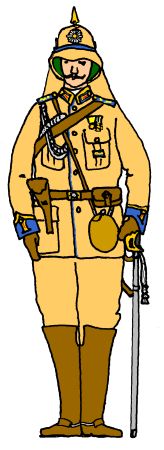 |
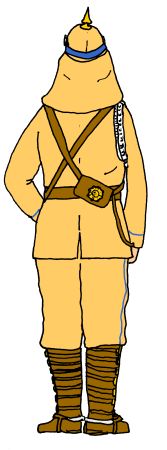 |
 |
 |
Figure 2
Generalfeldmarschal von Waldersee
East Asian Expeditionary Corps |
Figure 3
Vizewachtmeister
1. Zug, Leibgendarmerie |
Figure 4
Trooper
1. Zug, Leibgendarmerie |
Figure 5
Gefreiter
2. Zug, Leibgendarmerie |
Figure 6
Sergeant
2. Zug, Leibgendarmerie |
 |
 |
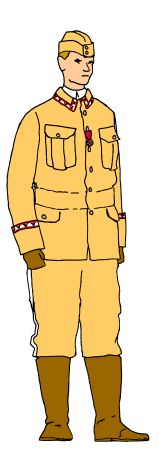 |
 |
Figure 7
Generalmajor von Scholl
1. Zug, Leibgendarmerie |
Figure 8
Trooper
2. Zug, Leibgendarmerie |
Figure 9
Trooper
Imperial Footmen |
Figure 10
Officer
Imperial Footmen |
|
Tropical Uniforms and Headdress
I have so far found no written
descriptions of these uniforms from the period nor official uniform
regulations. The information on this page is drawn only from examining
monochrome period photographs and the few contemporary illustrations
that I have found.
Uniforms
The uniform consisted of a khaki tunic with a stand and fall collar,
six buttons fastening the front and four buttoned pockets. The breast
pockets were pleated, the hip pockets were not. Trousers and riding
breeches were in matching khaki. The colour of collar, cuffs and piping,
the addition of Litzen on collars and cuffs and other details of the
uniforms depended on the arm of service of the wearer. These details are
described below.
Tropical Helmet
Headdress consisted of either a tropical helmet or
a side cap. The tropical helmet was khaki and tall with front and rear
peaks, similar to that briefly worn by the South West African
Schutztruppe around 1891. It had a removable spike (which was fluted for officers and plain for other ranks)
on a base (that was cruciform in shape for officers and round for other
ranks. On either side of the helmet was a large cockade, on the right in Imperial colours and on the left in
Prussian. The helmet plate and hatband varied for different troops, as
described blow. Some
photographs show a white helmet cover.
Side Cap
The side cap was clearly based on
a British design. It was fastened at the front with two metal buttons. The lower section of the hat
and piping across the top was in the same colour as the tropical helmet's
hatband. On either side of the cap was a small cockade, on the right in
Imperial colours and on the left in Prussian. The cap was worn with a brown leather chinstrap.
Cape
One photograph of the Leibgendarmerie (see
Pickelhaubes Forum) in tropical uniforms shows one wearing a waist
length cape. Its removable hood is shaped to be worn over the tropical helmet and
its spike and appears to have a drawstring around the face. The cape
was fastened at the front with two pairs of buttons.
Footwear
Footwear with the tropical uniform as of natural brown leather. Riding boots or ankle boots with gaiters were most commonly
worn. Gaiters worn by other ranks were of a similar type to those worn by the
East African Schutztruppe in
the Early 1890s, covering the top part of the foot and with six buckled
straps. Officers often wore privately purchased gaiters of varying
styles. Von Waldersee's Leibgendarmerie wore the high riding boots of
their home uniforms, but presumably in natural brown leather to match
their equipment.
Equipment and Weapons
Equipment with the tropical uniform as of natural brown
leather. The same basic equipment was worn by General and staff officers, consisting
of of a brown leather belt and
shoulder straps with a single pouch to the right side of the open
cavalry style buckle.
General and staff officers usually carried a sword on their left side,
depending on their arm of service and privately designed variations.
The Leibgendarmerie wore a similar belt
and pouch, without supporting shoulder straps. A holster to carry a
pistol (presumably the 1883 Reichsrevolver) was also worn on the right
side of the belt. The heavy cavalry "Pallasch" sword was carried
on the left side. A water bottle was carried on the left side from a
shoulder strap across the right shoulder, while the cartouche pouch was
carried on the back on a strap across the left shoulder. The cartouche
carried the Prussian Guard Star emblem in yellow metal. Officers wore an open cavalry style belt buckle,
other ranks wore a yellow metal oblong buckle with a white metal
Prussian Guard Star in the centre.
Arm of Service Variations
Generals
The collar and Swedish-style cuffs of the tunic were red with gold
metallic Litzen. The trousers had two broad red stripes down the
outside. The tropical helmet had a fluted spike, a yellow metal Prussian
Guards eagle on the front, and gold metallic cords around the hatband.
The side cap had red piping and lower half. It had small Prussian and
imperial cockades on the left and right sides respectively.
General Staff
The collar and Swedish-style
cuffs of the tunic were red with silver metallic Litzen. The trousers
had two broad red stripes down the outside. The tropical helmet had a
fluted spike, a white metal Prussian Guards eagle on the front, and
white metallic cords around the hatband. The side cap had red piping and
lower half. It had small Prussian and imperial cockades on the left and
right sides respectively.
Leib-Gendarmerie
The Imperial bodyguard consisted of
two platoons ("1. & 2. Zug"), both of which
accompanied the imperial entourage in Palestine.
The "Leib-Gendarmerie 1. Zug"
were the Kaiser's personal bodyguard and served as his
personal standard bearers and headquarter orderlies. The platoon
consisted of one officer ("Kommandeur der Leibgendarmerie"),
three NCOs (one Sergeant Major "Wachtmeister"
and two Corporals "Unteroffizier") and twenty troopers.
Their home uniform was a dark green cavalry Waffenrock with blue
collar and Polish style cuffs with yellow Litzen. Shoulder
straps were blue with a yellow metal crowned "WR"
monogram. Their helmet was cuirassier style in polished steel with a
"flying " eagle on top and the Prussian Guards star on the front.
The "Leib-Gendarmerie 2. Zug" were the Empress' ("Kaiserin") personal
bodyguard. The platoon consisted of an officer (always a
Premierlieutenant or Sekondlieutenant from the 2nd Queen's Own
Pomeranian Cuirassier Regt ("Kürassier-Regiment Königin (Pommersches) Nr. 2")),
two NCOs and 24 troopers. Their home uniform was
a white cavalry Waffenrock with collar and Polish style cuffs
piped in red with white Litzen. Shoulder straps were white, piped in
red. Their helmet was cuirassier-style in polished steel
with a "flying " eagle on top and the Prussian Guards star on the
front. They also had a Gala Dress 18th Century style uniform with a
coatee, again white with red facings and a black tricorn hat (see
Wikipedia).
White metallic lace braided
aiguillettes were worn across the right breast by all ranks of
both platoons with the home and tropical uniforms.
The tropical uniform of the two platoons
had piping down the front and around the collar and Polish style cuffs
in blue for the 1st and red for the 2nd. The collar and cuffs were in
the platoon colours for officers and senior NCOs and khaki with piping
in platoon colours for junior NCOs and other ranks. Litzen was worn on the collar
and cuffs in yellow metallic thread for the 1st platoon and white for
the 2nd. Shoulder straps were as worn on the home uniforms, blue with a
yellow metal crowned "WR" monogram for the 1st platoon and white
with red piping for the 2nd. Trousers were also piped in blue for the
1st platoon and red for the 2nd.
Musicians swallows nests were
also worn on the shoulder by the platoon trumpeters. As on the
Leibgendarmerie home uniforms they were blue with vertical
yellow metallic lace bands and fringing for the 1st platoon, and
red with diagonal white metallic lace bands for the 2nd.
|
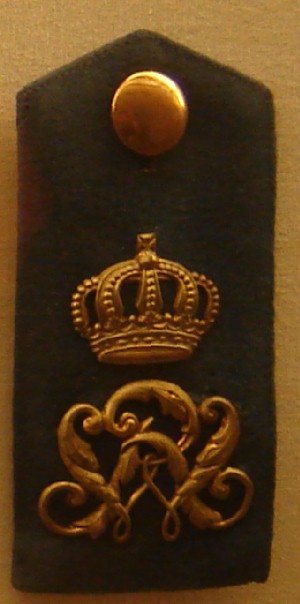
1. Zug Leibgendarmerie Shoulder
Strap
(Rastatt Museum Collection)
Photo by C Dale |
The Leibgendarmerie tropical helmet had a fluted spike
for officers and senior NCOs and plain for junior NCOs and other
ranks. A Prussian Guard Star was worn the front, in yellow metal
for the 1st platoon, white metal for the 2nd. A hatband in
in blue for the 1st and red for the 2nd platoons was worn on the
tropical helmet. While most period photographs show khaki
tropical helmets being worn, some show white helmets. It may be
that these were reserved for the 2nd platoon, matching their
home uniforms. The side cap had piping and the
lower half in blue for the 1st and red for the 2nd platoons. It
had small Prussian and imperial cockades on the left and right sides
respectively.
Imperial Footmen
I have so far found very little
information on the footmen of the imperial entourage. What I have
written here
is based only on observation of several period photographs and one
colour illustration of their home uniform (printed in "The Kaiser's Warlords"
by R Pawly and P Courcelle, Osprey Elite 97).
The collar and plain turn-back cuffs of the
khaki tunic were black for officers and senior NCOs and khaki for junior NCOs
and other ranks, both were edged in the same lace as worn on their home
uniforms. This lace was white edged in red and back and had black
Prussian eagles along its length. They wore no shoulder straps. Some photographs show footmen with plain khaki
trousers or riding breeches, and some show a broad white stripe on the
outside seem.
Their tropical helmets appear to have
been from a different manufacturer to the helmets worn by the staff and
Leibgendarmerie. They may have been bought from several different
sources. Some appear rounder than the Leibgendarmerie helmets, some
appear similar to British army helmets of the period (see photographs
below). The tropical helmets of the footmen had no spike or eagle on the front,
but from period photographs it appears that some members had a small cockade at the
front to replace the two on the sides worn by the Leibgendarmerie and
general officers. Officers had yellow
metallic cords around the hatband of the tropical helmet. The side cap
appears in period photographs to have been plain khaki without cockades.
Other Attendants
Period photographs also show plain khaki
uniforms with plain khaki side caps being worn by some other ranks
alongside footmen in Palestine. I am not sure exactly what their
position or titles were.
Local Additions to Uniforms
Many of the imperial entourage, including the Kaiser, wore loose white
drapes over their uniforms. These appear to have been purchased locally and vary
from some being simply a silk neckshade, hung from the headdress down
the back with others being a more full cape with arm holes.
Other Uniforms Worn in Palestine
The Kaiser and his staff did not always wear their khaki uniforms while
in Palestine. Period photographs show them wearing the full dress
of their home regiments on some days. A wide variety of Prussian army
uniforms were worn, the Kaiser in his white Gardes du Crops cuirassier
uniform, the 1st platoon of the Leibgendarmerie in their green uniforms
and the 2nd in their white with
other officers in dark blue Guard infantry, cavalry and artillery
uniforms.
The entourage consisted of almost
four hundred people in total (including 79 members of the court of the Kaiser,
8 members of the court of the Empress,
45 German clerics, 9 foreign clerics,
47 naval personnel and 171 other participants).
The sailors from the Imperial yacht
Hohenzollern, are seen in some photographs of the expedition on land
wearing a white naval shirt, dark blue trousers and tropical helmets with
white covers. Generally sailors from the Imperial yacht were distinguished
by having white collar patches on the Überzieher jacket although winter
jackets were probably not worn in Palestine.
The Empress' ladies in waiting and many
civilians on the trip did not of course wear uniform. Most wore their
European civilian dress often with privately purchased tropical helmets,
parasols and locally acquired loose white garments over the top.
See the
Period
Photographs below for examples of other uniforms worn in
Palestine.
Jerusalem Cross Medal
A mention should here be made of
the Jerusalem Cross ("Jerusalem
Kreuz"). It was a medal awarded to members of Kaiser Wilhelm II's entourage
during the Palestine expedition. Wilhelm personally awarded the medal
while in Palestine. The medal consisted of a Jerusalem Cross (made up of four
smaller crosses around a larger central one) in red enamel edged in gold
hung on a red ribbon.
Uniforms of Field Marshall Graf von
Waldersee
Photographs show that
Generalfeldmarschal Graf von Waldersee wore several different uniforms
while serving in China as commander of the German East Asian
Expeditionary Corps and also as Supreme Allied Commander in the
theatre. See period photographs of
Von Waldersee's Uniforms below.
1898 Tropical Uniform
Von Waldersee's tropical uniform was that of a General Officer of the
1898 Palestinian Expedition.
The collar and Swedish-style cuffs of the tunic were red with gold
metallic Litzen (von Waldersee's removable collar is
photographed along with his field marshal's baton in
"The German Colonial Troops 1889-1918" by
J Kraus and T Müller).
His shoulder straps were those of a general officer with field marshal rank- thick twisted white metallic cords on the
left and yellow metallic braided shoulder strap side with a
crossed field marshal's baton on the right. He wore aiguillette cords
are in yellow metallic thread for a general officer. The trousers and
riding breeches had two broad red stripes down the
outside.
With this uniform he wore three different
headdresses. The tropical helmet had a fluted spike, a yellow metal Prussian
Guards eagle on the front, and gold metallic cords around the hatband.
The side cap had red piping and lower half. It had small Prussian and
imperial cockades on the left and right sides respectively. Period
photographs show that a white generals peaked field cap was also worn
with red hatband and piping and a small Prussian cockade at the front.
Likewise his two Leibgendarmerie
bodyguards wore the 1898 tropical uniforms with tropical helmets as worn
in Palestine two years earlier.
Winter Uniforms
In colder weather von Waldersee is seen in
period photographs taken in China wearing the uniforms of his home regiment, the
13th Kings Own Hanoverian Lancers ("Königs-Ulanen-Regiment (1.
Hannoversches) Nr.13").
His tunic was the dark blue
double breasted lancer jacket ("Ulanka") with white piping, a white plastron front,
white Polish
style cuffs and officers metal epaulettes. His trousers were
matching dark blue, with officers thick stripes of white down the
side seems. He is also seen in period photographs wearing a similar
double breasted dark blue coat ("Überrock") again with a
white collar and piped in white and
at other times a double breasted, grey offices greatcoat ("Paletot") with dark blue
collar.
With the Lancer uniform he wore a square topped
lancer helmet ("Tschapka") with a white metal
Flying Prussian eagle with the battle honours Peninsula, Waterloo and
Garzia Hernandez scrolled across the front and an oval
Prussian cockade on the top. He also wore a
peaked field cap to match the Ulanka (dark blue with white
hatband and piping), it had a small Imperial
cockade above a Prussian cockade on the front.
All these items were as per regulation for
officers of the 13th Hanoverian Lancers. The uniform regulations of 6th July
1900 for
the East Asian Expeditionary Corps, stated that general and staff officers would
wear the uniforms of their home regiments in place of the Interimsrock worn by
other officers of the Expeditionary corps on formal occasions. Period
photographs
of von Waldersee's staff show them wearing infantry, artillery and several types of cavalry uniform
as worn in Germany.
1901 Tropical Uniform
During von Waldersee's stay in Peking a fire destroyed his
residence and with it many of his uniforms. I have seen no photographs of him
wearing his Lancer uniform latterly in China. New uniforms may have
been sent from Germany for him and possibly some made by local
tailors. One photograph taken in Japan in 1901 shows him wearing a
plain khaki uniform conforming roughly to the
9th February 1901 uniform regulations
for the East Asian Expeditionary Corps. Curiously the tunic has unpiped pointed Polish style cuffs
without buttons,
which appear to be a variation by the private tailor as such cuffs
were not specified in the regulations, nor are they usually
seen on officer's tunic of the period. Next to him, on a table is rested his new
Bortfeldt tropical helmet with a white hatband and imperial cockade on the
right
side, as authorised for generals of the
East Asian Expeditionary Corps from February 1901.
| |
|
|
| |
The Illustrations Figure 1 is based on a photograph
of Kaiser Wilhelm II, King of Prussia and German Emperor, taken in Potsdam shortly before departing
for Palestine in 1898. He is dressed typically for a General officer on
the visit to Palestine. He wears the khaki tropical uniform for general
officers. It has a red collar and Swedish style cuffs with yellow
metallic Litzen. His aiguillette cords are in yellow metallic
(gold) thread for a general officer. In this photograph the
Kaiser is only wearing one breast medal, probably the Prussian
Court Hunting Badge (see the
Prussian Hunting Badge Page at
Medal Net). As King of Prussia and
German Emperor he was entitled to wear dozens of Prussian and
German awards and those of foreign countries. In other
photographs taken later in Palestine he wears a few more medals
(including an unidentified cross at throat and one breast medal
on a ribbon) but never anywhere near his full compliment.
His tropical helmet is the same
as worn by other General and staff officers. It has the Prussian
Guard Eagle in yellow metal (gold) on the front, a fluted
yellow metal spike on a cruciform base, gold lace cords around
the hatband and a large cockade on either side (Prussian on the
left and imperial on the right).
His riding breeches have the
thick double red stripes of general and staff officers. As with
most officers he wears brown leather equipment and riding boots.
His sword was attached with a more supportive leather strap
system than usually worn by officers to compensate for his weak
left arm. This system is seen more clearly in other photographs
of the Kaiser in different uniforms, but was also used by other
officers on the Palestinian visit. On the sword is a Prussian
officers sword knot "Portepee" in white metallic lace
with black threads.
| |
Kaiser
Friedrich Wilhelm Viktor Albrecht von Hohenzollern (1859-1941), King of Prussia
and German Emperor ("Kaiser"). Wilhelm II acceded to throne after the short reign
of his father Kaiser Friedrich III in 1888. Germany was experiencing a
peak in national pride at the time. Recent victories against Denmark,
Austria-Hungary and France had united Germany and along with a boom in
industry and the acquisition of new colonies had made the new Empire into
a World Power. Wilhelm embraced all these advances especially in the
military and navy. There were several reasons for his visit to Palestine.
Firstly, as a devout Christian it was a Pilgrimage to the Holy
Land. It
was also a diplomatic mission to forge closer ties with
the Ottoman Empire and at the same time meet local
communities such as the German Colonists at Haifa and
Jewish leaders in Jerusalem. Wilhelm had an interest in the
region's history
and commissioned
the building of a new mausoleum for the Saracen
hero, Saladin (although in the end Saladin's body was
never placed in it). Acts such as these also created a
sympathetic view of the Kaiser in the Muslim world.
In 1914 the German , Austro-Hungarian and Ottoman
Empires sided together against Britain, France and Russia.
Their defeats in 1918 led to the fall of all three
Empires.
Wilhelm died in exile in Holland. |
Figure 2 is based on a studio photograph
of Generalfeldmarschal Graf von Waldersee, Commander of the East Asian Expeditionary
Corps taken in Germany shortly before departing for
China in 1900. He wears the khaki tropical uniform for general
officers with a red collar and Swedish style cuffs with yellow
metallic Litzen.
His shoulder straps are gold braid with a
crossed field marshal's baton. His aiguillette cords are in yellow metallic
thread for a general officer. In this photograph von
Waldersee wears three medals, the Grand Cross of
the Order of the Red Eagle at his
throat, a badge on his left breast (possibly the Prussian Court Hunting
Badge) and the
1870 Iron Cross, first class from the Franco-Prussian War below that. He
wears the side cap with piping and lower half in red for general
officers and small Prussian and imperial cockades on the left and right
sides respectively.
In his year in China, von
Waldersee wore a variety of uniforms, the tropical khaki one
illustrated here, several uniforms of his home regiment, the
the 13th Kings Own Hanoverian Lancers ("Königs-Ulanen-Regiment (1.
Hannoversches) Nr.13") and a different later replacement khaki uniform.
| |
Alfred Graf von Waldersee
(1832-1904) entered the Prussian artillery in 1850 and first saw
action in the Austro-Prussian War of 1866. Prior to the Franco-Prussian War
he was the Prussian military attaché in Paris. During that war he
served on the staff of the staff of the Grand Duke of
Mecklenburg-Schwerin. After the war he married a widowed American
heiress, Mary Lee and commanded the 13th Hanoverian Lancers, being promoted to chief of the staff of the Hanoverian army
corps and eventually chief of general staff in 1888. He was also on
close personal terms with both the chancellor, Bismarck and the
young Kaiser Wilhelm II accompanying the latter on trips abroad
before his accession to the throne. In 1900 Waldersee was given
command of the German East Asian Expeditionary Corps to
crush the Boxer Rebellion. He was also appointed commander in chief
of the entire allied mission in China including troops from
Great Britain, France, the United States of America, Italy, Russia
and Japan. He arrived in China shortly after the main fighting at
the siege of Peking was over and presided over the final mopping up
operations. As overall commander, his diplomatic approach
soothed the squabbles of the victorious allies. He returned to
Germany 1901. |
Figure 3 is based on a photograph
of a Vizewachtmeister of the 1st Platoon of the Leibgendarmerie taken in Germany shortly before departing
for China in 1900 as one of von Waldersee's two personal bodyguards. He wears the khaki tropical uniform with
the yellow metallic Litzen and blue collar, cuffs and piping of
the 1st platoon. The shoulder straps are the 1st platoon's
blue with yellow metal crowned "WR" monogram. The yellow metallic lace on the
collar and cuffs and the large collar buttons indicate his rank
as Vizewachtmeister. He wears the white metallic lace braided
aiguillettes were worn across the right breast by all ranks of
both platoons of the Leibgendarmerie. His medals cannot be made out for certain
in the original photograph upon which this illustration is based but
one appears to be the 1897
Wilhelm I Centenary Medal.
Lower on his pocket is a Prussian long service award.
He wears the khaki tropical
helmet with Guard Star, blue hatband for the 1st Platoon and
khaki neckshade. The spike for the helmet should presumably be
fluted on a cruciform base for that of a senior NCO although it
cannot be seen for certain in the original photograph upon which
this illustration is based.
His boots are the high cuirassier
riding boots of the Leibgendarmerie on home service but appear
to be in natural brown leather.
The equipment is typical for the
Leibgendarmerie in tropical uniform and consists of a brown
leather belt
and pouch, a holster to carry a
pistol , the heavy cavalry "Pallasch" sword, a water bottle carried on a
strap across the right shoulder and the strap for the cartouche pouch across the left.
The buckle is the other ranks yellow metal oblong with a white
metal Guard Star.
Figure 4 is based on a photograph
of a Trooper of the 1st Platoon of the Leibgendarmerie taken in Germany shortly before departing
for Palestine in 1898. He wears the khaki tropical uniform with
the blue piping of
the 1st platoon, also noticeable on the trousers. He wears the white metallic lace braided
aiguillettes by all ranks of
both platoons of the Leibgendarmerie, here seen tied around the
right shoulder. Note the slit in the rear of the tunic skirt to
facilitate mounted duties. He wears the khaki tropical
helmet with blue hatband for the 1st Platoon and khaki
neckshade. The spike for the helmet would be plain for other
ranks on a circular base.
He wears short brown leather
boots with gaiters with six straps and buckles, seen clearly
from the rear. The equipment is typical for the Leibgendarmerie
in tropical uniform and consists of a brown leather belt
and shoulder straps carrying the cartouche pouch seen here with its
Prussian Guard Star.
Figure 5 is based on a photograph
of a Gefreiter of the 2nd Platoon of the Leibgendarmerie taken in Germany shortly before departing
for China in 1900 as one of von Waldersee's two personal bodyguards. He wears the khaki tropical uniform with
the white Litzen and red piping of
the 2nd platoon. The shoulder straps are the 2nd platoon's
white with red piping. The small collar button at the rear of
his collar :Litzen indicates his rank
as Vizewachtmeister. He wears the white metallic lace braided
aiguillettes were worn across the right breast by all ranks of
both platoons of the Leibgendarmerie.
He wears a white tropical helmet
with Guard Star, red hatband for the 2nd Platoon and khaki
neckshade. He is the only other ranks member of the Leibgendarmerie I have
seen with a white helmet, yet several period photographs confirm
its shade. The large Prussian cockade on the left side can
clearly be seen. The spike for the helmet should presumably be
plain for other ranks although it cannot be seen for certain in
the original photograph upon which this illustration is based.
His boots are the high cuirassier riding boots of the
Leibgendarmerie on home service but appear to be in natural
brown leather.
The equipment is again typical
for the Leibgendarmerie in tropical uniform and consists of a
brown leather belt
and pouch, a holster to carry a
pistol , the heavy cavalry "Pallasch" sword, a water bottle carried on a
strap across the right shoulder and the strap for the cartouche pouch across the left.
The buckle is the other ranks yellow metal oblong with a white
metal Guard Star.
Figure 6 is based on a photograph
of a Sergeant of the 2nd Platoon of the Leibgendarmerie taken in Germany shortly before departing
for Palestine in 1898. He wears the khaki tropical uniform with
the white Litzen and red collar, cuffs and piping of
the 2nd platoon. Note the trouser piping. The shoulder straps are the 2nd platoon's
white with red piping. The white metallic lace around his collar
and cuffs and small collar button at the rear of his collar
Litzen indicates his rank
as Sergeant. He wears the sided cap with piping and lower half
in red for the 2nd platoon, note the small Prussian cockade on
the side.
He wears short brown leather
boots with gaiters with six straps and buckles, seen clearly
from the side. The equipment is typical for the Leibgendarmerie
in tropical uniform and consists of a brown leather belt
carrying the the heavy cavalry "Pallasch" sword (with its
Prussian white and black "Faustriemen" sword knot) and
shoulder strap carrying the cartouche pouch.
Figure 7 is based on a photograph
of Kommandeur der Leibgendarmerie und Diensttuende General à la suite SM
General-Major von Scholl taken in Germany shortly before departing
for Palestine in 1898.
He wears a white
officer's Paletot double breasted coat with a blue collar for the 1st
platoon of the Leibgendarmerie. On his right breast are the white
metallic aiguillette cords of the Leibgendarmerie. His trousers are in
white as were the usual home uniform trousers of the Leibgendarmerie and
are tucked into privately purchased leather gaiters and ankle boots. He
wears the tropical helmet with a white cover and neckshade.
| |
Friedrich von Scholl (1846-1928)
was first commissioned as Sekondlieutenant in the 1st Prussian
Guard Lancers ("Garde
Ulanen Regiment Nr. 1") in
1865. By the mid 1890s he was
commander of Kaiser Wilhelm II's bodyguard, the Leib-Gendarmerie
and Palace guard, the Schloßgarde and Leibgarde. He remained in
this position until the Kaiser's abdication in 1918, having also
been appointed as Generaladjutant to the Kaiser on the outbreak
of war with the rank of Generaloberst.
Recommended External Link -
Biography on the Prussian Machine |
Figure 8 is based on a photograph
of a Trooper of the 2nd Platoon of the Leibgendarmerie taken in
Germany shortly before departing for Palestine in 1898. He wears
the same khaki uniforms, tropical helmet and brown leather
equipment, sword, boots and gaiters as worn by the previous
Leibgendarmerie figures. Over this uniform he wears a cape. This
illustration is based on the only period photograph I have seen
of the tropical cape. It appears to be a waist length cape with a
removable hood shaped to be worn over the tropical helmet and
its spike and appears to have a drawstring around the face. It
appears to be fastened at the front with two pairs of buttons.
Figure 9 is based on a photograph
of an Imperial Footman taken in Palestine in 1898. He wears the
khaki tropical uniform with the white lace, edged in red and black with
small Prussian eagles along it (from the home uniform of the imperial
footmen) on his collar and cuffs. Note that the waist of the tunic is
drawn in when seen without a belt. He wears a newly awarded Jerusalem
Cross medal from his second tunic button. His headdress is the plain khaki
side cap. He wears khaki trousers with a broad white stripe and
leather riding boots.
Figure 10 is based on a photograph
of an Officer of the
Imperial Footmen taken in Palestine in 1898. He wears the
khaki tropical uniform with black collar and cuffs with white lace, edged in red and black with
small Prussian eagles along it. His headdress is a tropical
helmet. It appears lower and rounder than those worn by the
Leibgendarmerie, has no imperial eagle but does appear to have a
small cockade at the front and officers yellow metallic cords
around the hatband. He wears khaki trousers, though from the
original photograph upon which this illustration is based, it cannot
be seen if he has the broad white stripe down the edge. He wears the
same brown leather gaiters and short ankle boots as worn by the
Leibgendarmerie in Palestine. His belt is similar to that of a
Prussian army officer (white metallic silk with black stripes) with
the Prussian crown on the buckle. His weapon appears to be some kind
of short sword although it cannot be seen clearly enough for
positive identification in the photograph upon which this
illustration is based.
|
|
| |
|
|
|
|
|
Period Photographs
of Kaiser Wilhelm II's Expedition to Palestine
|
|
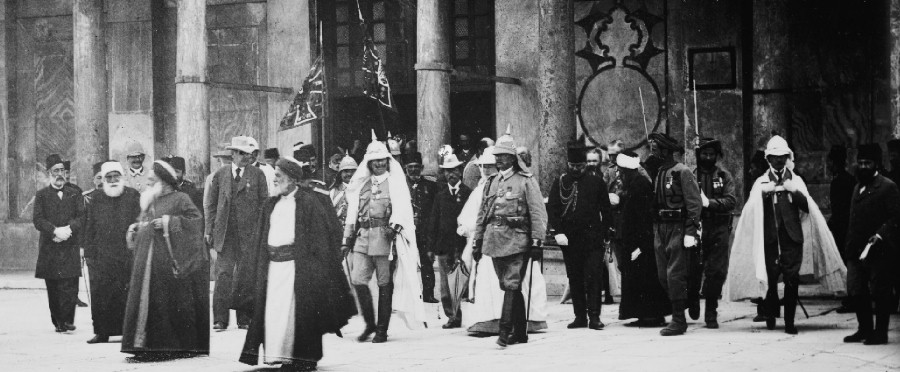
Kaiser Wilhelm II and the Imperial Entourage,
Jerusalem 1898
This photograph shows Kaiser Wilhelm II and his entourage at the Temple Mount
in Jerusalem. The Kaiser, in the centre, wears his khaki tropical uniform and
tropical helmet. The helmet has a white cover and a loose white cloak is worn
from it. The general walking with him also wears the khaki uniform and tropical
helmet. He has no cover on his helmet and his "flying" Guard eagle,
Prussian cockade and neckshade can clearly
be seen in the close up below.
Behind
the Kaiser can just be seen two members of the Leibgendarmerie bearing their
imperial standards. In the close up below it can be seen that they both wear
khaki tropical helmets with the Guard star on the front.
To the right of the photograph can be seen two
Ottoman Zouaves of the Imperial Guard. Their uniforms are not dissimilar
to those worn by the Zouaves of the French and American armies. They are blue
with red edging and a red waistband. For headdress a green turban
("Keffiyeh")
is worn wrapped around a red fez.
Their ankle boots and
gaiters are French army pattern in black leather. Their medals cannot be clearly
made out. They may possibly include the Ottoman medal to commemorate the
Kaiser's previous visit to Istanbul in 1889 or the Medal for the Greco-Turkish War of 1897.
Elsewhere in the photograph are some
civilians in the Kaiser's entourage (note the gentleman on the right in
a western suit with a tropical helmet and loose white cape), Ottoman
army officers in dark blue uniforms with red fezzes and .Muslim
leaders in traditional clothing.

| In the left
background of the photograph can be seen the head and shoulders of an
imperial footman (see close up on the right).
He wears a tropical helmet without a
front plate or coloured hatband. The chinstrap is folded over the front
peak. It appears to be more similar in shape
to British helmets of the period rather than the helmets worn by other
members of the imperial entourage. It may well be a privately purchased
item.
He wears the khaki tropical uniform, the
dark coloured collar (probably black) may indicate that he is a senior
NCO or officer. Note the footmen's lace
with small Prussian eagles around the collar.
Photo from G. Eric and Edith Matson Photograph Collection, US Library of
Congress /
WikiCommons
|
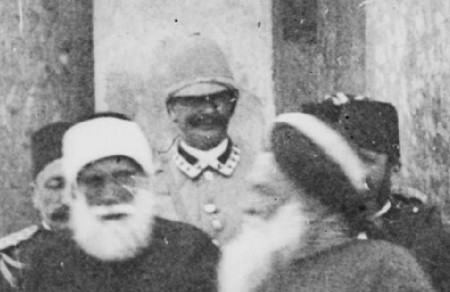 |
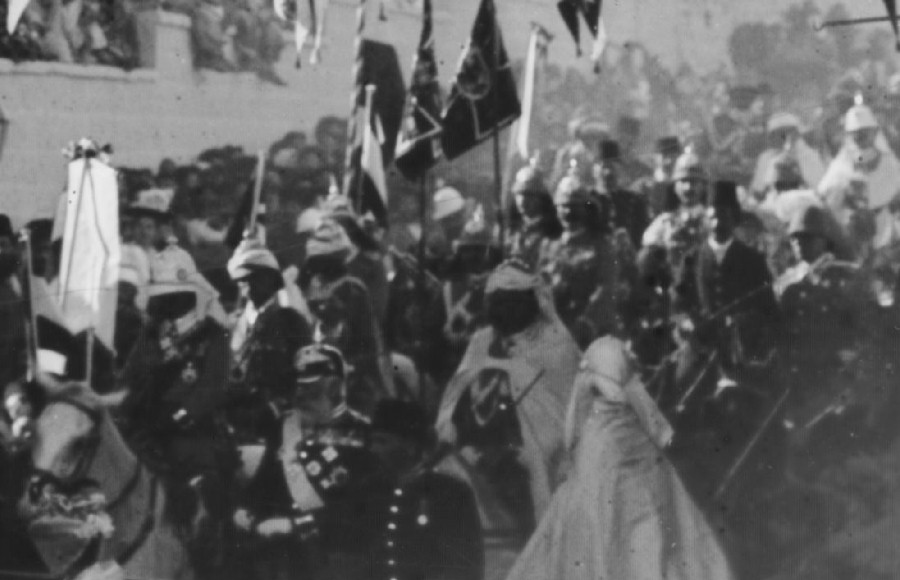
Kaiser Wilhelm II and the Imperial Entourage,
Jerusalem 1898
The Kaiser and his entourage at the arch erected to celebrate the Imperial
visit by the Jewish community of Jerusalem. Most wear the tropical uniform.
Note
the variety of khaki and white tropical helmets and loose white gowns worn over
them.
Photo from G. Eric and Edith Matson Photograph Collection, US Library of
Congress /
WikiCommons

Kaiser Wilhelm II and the Imperial Entourage,
Jerusalem 1898
The Kaiser and his entourage in Muristan, Jerusalem. In this photograph
they wear European uniforms. There is a fabulous array of uniforms on view.
Wilhelm wears the uniform of the Prussian Gardes du Korps cuirassier regiment,
complete with cuirassier helmet with eagle on top and Guard star on front,
breastplate and high boots. Over his uniform he wears a white coat. I can only
hope he didn't have to walk far in this outfit in the heat of Jerusalem. The
Empress, Kaiserin Augusta sensibly carries a parasol just to the right. Her
ladies in waiting appear to be struggling to keep up with the pace in their long
dresses behind the Empress.
Behind the imperial couple are two guardsmen from the 1st
Platoon
of the Leibgendarmerie bearing the imperial standards and wearing their dark green
home uniforms and cuirassier style helmets. In the upper right of the photo is
trumpeter from the 2nd Platoon of the Leibgendarmerie wearing the white home uniform
piped in red and cuirassier style helmet. Note the musicians swallows nests.
In the right foreground with an ostrich-plumed hat, is Prince Albrecht of Prussia ("Prinz Albrecht von Preußen")
in the uniform of Herrenmeister of the Johanniter Order, a Prussian Protestant
Order of Knighthood always headed by a high ranking member of royalty. His tunic
is red with white facings and gold lace.
Prussian army
officers can be seen in dark blue uniforms with Pickelhauben with the spikes replaced by
parade plumes (or feathers for general officers).
Several Ottoman officers are also in dark blue
uniforms with the black wool "Kalpak" headgear or a red fez.
The Kalpak was only authorised for all army officers from 1909, but was worn
prior to then by officers of the cavalry and artillery. It has been speculated
that the three officers in the top centre right of the photograph may be
German officers then serving as Generals in the Ottoman army (Kamphoevener
Pascha and Baron Von Hobe Pascha both serving in the cavalry and Pasha von
Grumbkow
of the artillery).
Baron Von der Goltz Pascha, the Inspector General of the Ottoman army may also
have been present.
On the far right of the photo is a Zouave of the Ottoman
Imperial Guard (wearing the blue uniform and green turban as described above). Note that every male in the photograph,
including the Zouave has a full breast of medals.
Photo from G. Eric and Edith Matson Photograph Collection, US Library of
Congress /
WikiCommons see also
Pickelhaubes Forum
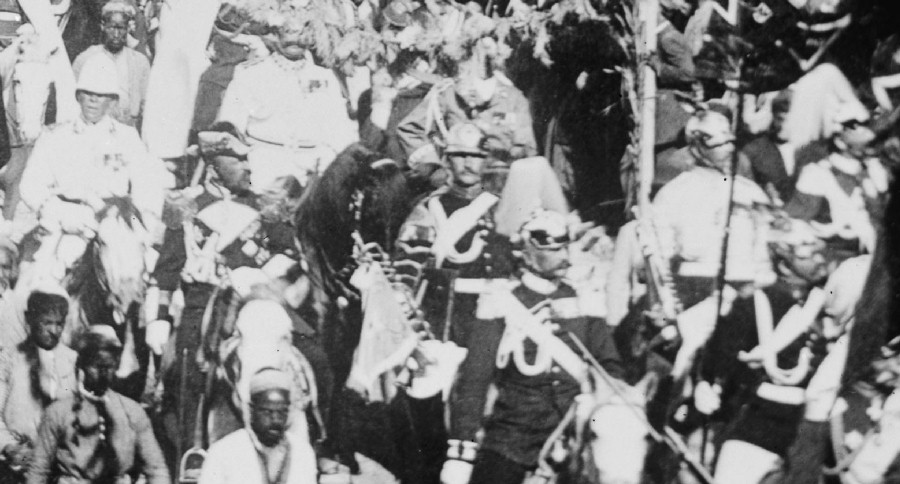
Imperial Entourage, Jerusalem 1898
The imperial entourage on the Jaffa Road, Jerusalem. Most wear European
uniforms. An officer of the footmen on the left of the photograph is the
obvious exception. Note his cuff and collar lace, and impressive medal bar.
Just the the right is a imperial naval officer in dark blue frock
coat and
cocked hat. Further right is a trumpeter of the 1st Platoon of the Leibgendarmerie in
dark green home uniform
with cuirassier helmet. Note the lace bars on his sleeve to denote him as a
musician.
In front of him is a Prussian Guards Infantry officer, also in
European Uniform with Guards eagle on his Pickelhaube which has the parade white
plume rather than a spike. Note the Litzen on his collar and cuffs.
To the right
of him is a standard bearer of the 1st Platoon of the Leibgendarmerie again wearing
the dark green home uniform
and cuirassier helmet.
Photo from G. Eric and Edith Matson Photograph Collection, US Library of
Congress /
WikiCommons
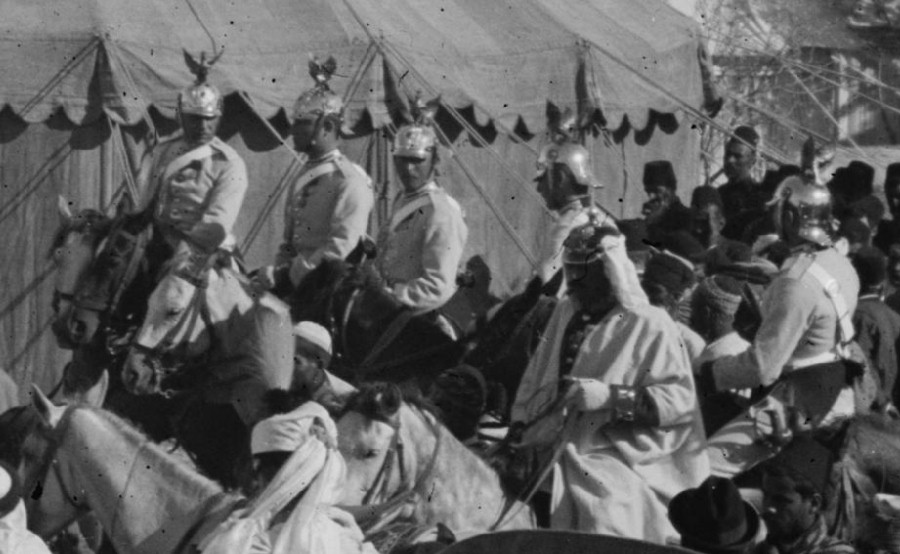
Second Platoon Leibgendarmerie, Jerusalem 1898
This photograph shows troops of the 2. Zug
of the Leibgendarmerie in European Uniforms mounted in camp
at Jerusalem. They wear the white cavalry Waffenrock with red collars and Polish
cuffs and white Litzen of the 2nd Platoon. They are also wearing the polished steel
Cuirassier helmet with "flying" Prussian eagle on top and Guard star on the
front. The "lobster tail" neckguard of the helmet can clearly be seen on the
figure on the right.
The officer in the foreground wears a dark blue
tunic with Swedish style cuffs with Litzen and
therefore is not from the Leibgendarmerie, but from a guard unit of the
Prussian army. He wears a dark blue Waffenrock and black leather Pickelhaube
bearing the Guard star. He has an improvised neckshade tucked into the
chinscales of his helmet and wears a long loose white gown over his uniform.
Photo from G. Eric and Edith Matson Photograph Collection, US Library of
Congress /
WikiCommons
 |
|
Imperial Footman, Berlin 1898
This photograph shows an Imperial Footman in Tropical Uniform after his
return from Palestine. He wears the khaki uniform and side cap with lace
around the collar and cuffs showing the Imperial Eagle in black on a
white background edged in red and black.
He wears the Jerusalem Cross in his second
buttonhole and the Ottoman
Medjidie
Order on his left breast.
Photo ©
Joe Robinson |
| |
|
|
|
|
The two pictures above show Generalfeldmarschal von Waldersee in
tropical uniform.
The picture above left is a popular period postcard
based on a photograph of von Waldersee in his tropical uniform. Note the
generals yellow metallic aiguillette cords. He has an impressive display of
Prussian medals. The most senior are the Grand Cross of the Order of the Red
Eagle at his throat with its accompanying breast star and the Grand Commander ("Großkomtur")
collar of the Royal House Order of Hohenzollern. On his breast he wears an 1870
Iron Cross first class below the aforementioned Order of the Red Eagle star and
a General Adjutant's badge. His medal bar consists of an 1870 Iron Cross second
class with 25th anniversary clasp, Knight's Cross of the Royal Hohenzollern
House Order, Red Eagle Order fourth class with swords, Officer's Long Service
Cross, 1870 War Medal with numerous clasps, 1866 War Medal, Mecklenburg-Schwerin
Military Merit Cross second class and one unidentified medal (see
Discussion on von Waldersee's Medals
at the GMIC).
The photograph above right shows von Waldersee at the head of
his bodyguards. He wears the khaki spiked tropical helmet with khaki uniform.
Behind him are his two bodyguards of the Leibgendarmerie carrying his German
Field Marshal's banner (striped from top to bottom in black/white/red with a
black Iron Cross in the centre and crossed Field Marshal batons) and other
members of his staff. They also wear khaki uniforms and tropical helmets. On the
left of the photograph is an officer of the German East Asian Expeditionary
Corps wearing the unique straw hat (see
East Asian Expeditionary Corps). On the
right of the photograph is a British Indian Bengal Lancer, noticeable in his
turban.
The two photographs below show him wearing the home uniform of the 13th
Kings Own Hanoverian Lancers ("Königs-Ulanen-Regiment (1.
Hannoversches) Nr.13").
The photograph below left shows von Waldersee inspecting
Italian Bersagleri Infantry in China in 1901 in his role as overall Commander of
Allied Armies in China. He wears the dark blue Lancer tunic ("Ulanka") of the 13th
Lancers piped in white and a matching peaked cap. Perhaps more interesting is a figure to the left of the
photograph, the Gefreiter of the 2nd platoon of the Leibgendarmerie wearing the
khaki tropical uniform and a white tropical helmet with red hatband.
The photograph below right shows von Waldersee again inspecting
Allied soldiers. In this photograph he wears the Lancer helmet ("Tschapka")
and cavalry officers grey double breasted greatcoat ("Paletot").
Photos from
WikiCommons- Graf von Waldersee and
WikiCommons- Von Waldersee Inspecting the Italians
Main Printed Sources
"Der
Kaiser Reist ins Helige Land" by Alex Carmel & Ejal Jakob Eisler (Verlag W.Kolhammer)
"Tropenhelme der kaiserliche Marine, der
Ostasiatischen Truppen und der Schutzruppen"
by Ulrich Schiers (Deutsche Gesellschaft für Heereskunde)
"Zeitschrift für Heeres- und
Uniformkunde" (April/May/June 1936 Edition)- contains a photograph
of von Waldersee's bodyguard
"Deutsche Expeditionstruppen und Schutztruppen" by Edgar Graf von
Matuschka - contains colour illustrations of Waldersee and his bodyguard
"The Kaiser's Warlords" by Ronald Pawly and Patrice Courcelle (Osprey
Elite)- this book contains the only colour illustration I have so far found of
the imperial footmen in their home uniforms
"Das Deutsche Heer, Friedensuniformen bei Ausbruch des Weltkrieges " by
H. Knötel and P. Pietsch (Diepenbroick-Grüter & Schulz) - shows the home
uniforms of the
Leibgendarmerie
"The German Colonial Troops 1889-1918" by
Jürgen Kraus and Thomas Müller
(Verlag)
"Uniforms of the German Soldier - 1870 to the End of World War One" by
Alejandro M. De Quesada (Greenhill)
Main Online Sources and Recommended External Links
Discussions on the
Pickelhaubes Forum
on the
Leibgendarmerie in Tropical Uniform, the
Leibgendarmerie, a
Leibgendarmerie Helmet and the
Johanister Order
Discussion on the
Jerusalem Voyage on the Axis History Forum
Discussion on the
Jerusalem Cross at the
Gentlemens Military
Interest Club
Discussion on the
Jerusalem Cross and Palestine Voyage on the Wehrmacht Awards Forum
The Jerusalem Cross and Other Commemoratives of the Palestine Visit at
Israeli Decorations
German Wikipedia article on
Palästinareise Kaiser Wilhelms II
and the
Leibgendarmerie
Wikipedia article on and
Fritz Rosen
Photographs of the Kaiser and the Zionist
Delegation in Palestine at the
Zionist Archives
Another photograph at the
Huis Doorn
Photograph Collection
WikiCommons images of
The Leibgendarmerie by Krickel,
The Leibgendarmerie by Knötel,
Leibgendarmerie Uniforms from a Postcard
And thanks very much to Peter Abbot,
Mike Dwyer, Christopher Flaherty and Mike Blake for their generous help on this subject.
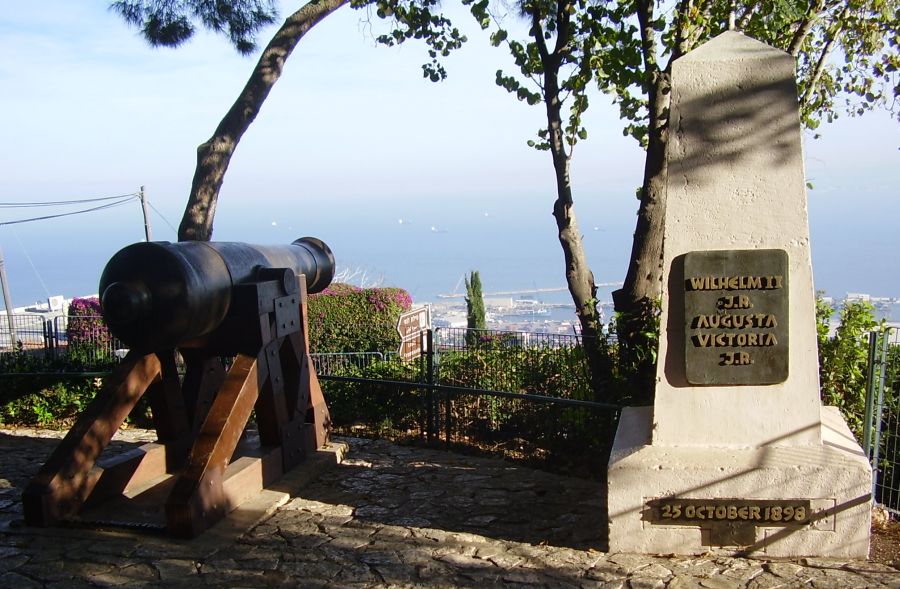
The Kaiser Wilhelm II Obelisk on Mount Carmel in Haifa
looking out to see where the Imperial yacht Hohenzollern first anchored. The cannon next to it
is an Ottoman one, probably from the early 19th century.
Photo by Dr. Avishai Teicher at
Wikimedia
|
|




















